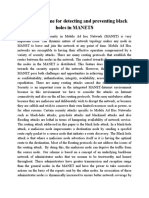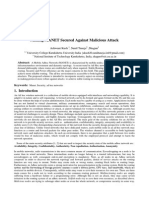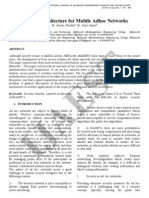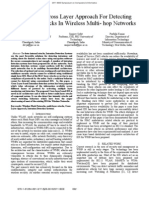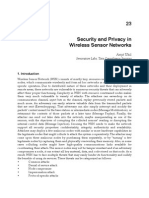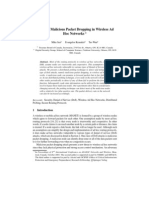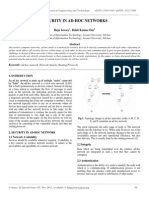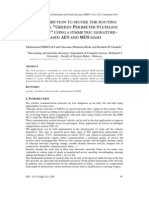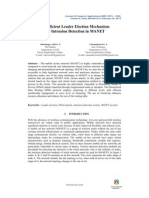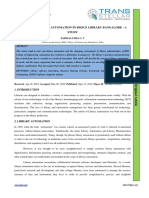27 Different Full
27 Different Full
Uploaded by
TJPRC PublicationsCopyright:
Available Formats
27 Different Full
27 Different Full
Uploaded by
TJPRC PublicationsOriginal Title
Copyright
Available Formats
Share this document
Did you find this document useful?
Is this content inappropriate?
Copyright:
Available Formats
27 Different Full
27 Different Full
Uploaded by
TJPRC PublicationsCopyright:
Available Formats
International Journal of Computer Science Engineering and Information Technology Research (IJCSEITR) ISSN 2249-6831 Vol.
3, Issue 1, Mar 2013, 233-238 TJPRC Pvt. Ltd.
DIFFERENT SECURITY ISSUES OVER MANET
PRATIK GITE & SANJAY THAKUR Department of Computer Science and Engineering, Lord Krishna College and Technology, Indore, India
ABSTRACT
Researchers and engineers are making efforts to design and implement a high secure, efficient and reliable network for next generation. One of the efforts that are well known in this direction is known as MANET (mobile ad hoc network). MANET is much popular and area of interest for researchers due to their ad hoc nature and self- organizing capability. But this nature of network produces or introduces some security issues. In this paper we provide a brief analysis and behavior of the different security issues and their properties. Additionally we provide the main source where these problems are arises.
KEYWORDS: Properties, Effects, MANET, Security, Ad Hoc Nature INTRODUCTION
A mobile ad-hoc network (MANET) is a network that is composition of mobile nodes. With the mobility of nodes they are mainly described by the absence of any centralized or fixed network coordinator in the network infrastructure, which makes any node in the network act as a potential router. MANETs are also characterized by a dynamic, random and rapidly changing topology. This makes the classical routing algorithms fail to perform correctly, since they are not robust enough to accommodate such a changing environment. Consequently, more and more research is being conducted to find optimal routing algorithms that would be able to accommodate for such networks. In MANETs, communication between mobile nodes always requires routing over multi-hop paths because of their moving nodes. Since no infrastructure exists and node mobility may cause frequent link failure, it is a great challenge to design an effective and adaptive routing protocol. Many restrictions should be well considered, such as limited power and bandwidth. Security has become a primary concern in order to provide protected communication between mobile nodes in a hostile environment and the ultimate goal of the security solutions for MANETs is to provide security services such as Confidentiality, Integrity, Availability, Non-Repudiation and Authentication, Authorization and Anonymity. Confidentiality ensures that Secret information or data is never disclosed to unauthorized devices. Integrity tells that a received message is not corrupted. Availability permits the survivability of network services despite Denial-of-Service attacks. Non-repudiation ensures that the sender of a message cannot deny having sent the message. Authentication enables a node to ensure the identity of the Peer node it is communicating with. Authorization is a process in which an entity is issued a credential, which specifies the privileges and permissions it has and cannot be falsified, by the certificate authority. Anonymity ensures that the information used to identify the owner or the current user of the node should default be kept private and not be distributed by the node itself or the System Software. In this part of the given paper we discuss the basic need of the security in MANET environment. in next section of our paper we discuss the different security attacks formed in the MANET and their main domain of challenges.
234
Pratik Gite & Sanjay Thakur
Different Kinds of Attack in MANET In any network design or any system design performance is the main area of concern additionally security in data and network is one of the main goal to achieve for a good and adoptable architecture design. in this paper we focus on the security issues and their main reason by which they form in any network. here below given a list of various kinds of attacks which is frequently form in the MANET. Black Hole Attack: A Black hole is formed during the week routing infrastructure. When a malicious node joins the network this problem arises. This node falsely replies for route requests without having an active route to the destination and exploits the Routing Protocol to advertise itself as having a good and valid path to a destination node. actually in AODV routing for find the path between source and sink RREQ packets are flood and all the path replies with RREP packets if malicious node RREP is arrive first then the requester node suppose the provided information is correct and reply with the data packets.
Figure 1 As shown in Fig 1, a malicious node tries to become an element of an active route which is reply first, if there is a chance and it has bad intention of disrupting data packets being sent to the destination node or obstructing the route discovery process. Wormhole Attacks: In a wormhole attack more than one malicious nodes are join the network and according to the nodes they are connected thorough high speed data buses by which they promises to send data from source to sink, the formation of attack is driven as a malicious node can record packets at one location in the network and tunnel them to another location through a private network shared with a colluding malicious node. Wormhole attack can be done with one node also, but generally two or more attackers connect via a link called wormhole link. Wormhole attack is of three types: Closed Wormhole, Half Open Wormhole, and Open Wormhole.
Figure 2
Different Security Issues over MANET
235
DoS and Flooding: the DOS and flooding attacks are the most frequent attacks that are formed. these attacks are depends upon the packets that flood during communication. In Denial-of-Service (DoS) attack, an attacker attempts to prevent legitimate users from accessing information or services.
Figure 3 By targeting client computer and its network connection, or the computers and network of the sites client is trying to use, an attacker may be able to prevent the client from accessing email, websites, online accounts, or other services that rely on the affected computer. The most common and obvious type of DoS attack occurs when an attacker floods a network with information as shown in Fig 3., the server can only process a certain number of requests at once, so if an attacker overloads the server with requests, it can't process the legitimate request. Eavesdropping: Eavesdropping is another kind of attack that usually happens in the Mobile Ad hoc Networks and is shown in Fig 4 for this attack the routing nature is responsible for the attack. The goal of eavesdropping is to obtain some confidential information that should be kept secret during the communication. This confidential information may include the location, public key, private key or even ass words of the nodes. Because such data are very important to the security state of the nodes, it should be kept away from unauthorized access. this unauthorized access Network Eavesdropping or network sniffing is a network layer attack consisting of capturing packets from the network transmitted by others' computers and reading the data content in search of sensitive information like passwords, session tokens, or any kind of confidential information. The attack could be done using tools called network sniffers. These tools collect packets on the network and, depending on the quality of the tool, analyze the collected data like protocol decoders or stream reassembling.
Figure 4
236
Pratik Gite & Sanjay Thakur
Rushing: When a neighbor of the target receives the rushed REQUEST from the attacker, it forwards that REQUEST,
Figure 5 and will not forward any further REQUESTs from this Route Discovery. When non-attacking REQUESTs arrive later at these nodes, they will discard these legitimate REQUESTs as shown in Fig 5. Grayhole Attacks: A Gray hole attack is much similar to the two attack black hole and worm hole attack. in this attack nodes forward all packets to certain nodes but may drop packets coming from or destined to specific nodes as shown in Fig 6. In this type of attack, node may behave maliciously for some time but later on it behaves absolutely normally. This type of attacks is more difficult compared to black hole attack.
Figure 6 Impersonation: An Act whereby one Entity assumes the identity and privileges of another Entity without restrictions and without any indication visible to the recipients of the impersonator's calls that delicately has taken place as shown in Fig 7.
Figure 7
Different Security Issues over MANET
237
From the above discussion we found that the most of the attacks in the MANET is formed during the routing mistakes or from the authentication and un-authorization gaps. in the next section we discuss the problem that are responsible for forming these attacks.
ROUTING
In any network infrastructure the routing algorithms and routing strategy provide the key or main role. Here we discuss some routing protocols and the infrastructures gap that is responsible for these attacks. Here we provide a small table by which we analysis the problem in attacks.
Attack Gray hole Black hole Worm hole DOS
Formed by Routing Routing Routing Routing
By the above given table we can easily conclude that the most of the problem is found during the routing of the data packets over network. Another main reason of the attacks is there is a gap between the dynamic infrastructures of the MANET.
MANET
MANET is defined by the self-organizing and infrastructure less network organization. Where no centralize authority is available and all nodes are independently follow the routine of mobility. Due to absence of the centralize authority the attacker easily join the network and perform the malicious activity. beyond this gap to overcome this fault or problem various trust based security architecture are proposed for MANET but most of them are theoretical efforts of designers or the performance issues with the architecture. Thus they are not completely adaptable for the MANET infrastructure.
AODV
This protocol is frequently used in the MANET network design and analysis of the performance of the system. the major gap in this protocol it is not updatable and at the time of requirement this protocol is active and make effort for route discovery. During this it can be adopt or automatically join the malicious node.
DSDV
The advance version of this routing protocol is used as the AODV. this routing is a table driven routing protocol in this protocol system keep the routing and path information from all time and it is updated at each route discover. But due to mobility sometimes this is fails to provide the correct information and again route discovery is performed. In the above section we can see both kinds of routing algorithms table driven and without table driven routing protocols. The main problems are listed below In on demand routing strategy we can save battery power and energy consumption during the data transfer but we can easily join the malicious nodes in the network. In on demand routing when required than a path is discovered thus it is good for links which is brake during its mobility model.
238
Pratik Gite & Sanjay Thakur
In table driven routing we can allow nodes and keep the path information but during update rapidly can consumes the node energy rapidly
The nodes with low energy or in sleep mode may not participate in route discovery process. Due to the above problems we can conclude the effects and reaching in the domain of enhancing and exploring
the domain of routing protocols and their methodology.
CONCLUSIONS
In this paper our main goal to analyze and make review of traditional security issues in the network formation. Additionally we recover that the actual problem is belongs to the attack formation and where they effect in the communication. In future we decide to work with the routing algorithm and performance analysis during the attacks and normal conditions. According to these reviews we propose an adoptable way to find a high performance, robust and secure routing protocol.
REFERENCES
1. Highly Dynamic Destination-Sequenced Distance-Vector Routing (DSDV) for Mobile Computers, and/or specific permission. SIGCOMM 94 -8/94 London England UK @ 1994 ACM 0-89791 -682-4/94/0008..$ 2. An Efficient Black Hole Detection Method using an Encrypted Verification Message in Mobile Ad Hoc Networks, International Journal of Security and Its Applications Vol. 6, No. 2, April, 2012 3. WormCircle: Connectivity-based Wormhole Detection in Wireless Ad Hoc and Sensor Networks. 2009 15th International Conference on Parallel and Distributed Systems, 1521-9097/09 $26.00 2009 IEEE DOI 10.1109/ICPADS.2009.97 4. Label-BasedDV-Hop Localization Against Wormhole Attacks in Wireless Sensor Networks, 978-0-7695-41341/10 $26.00 2010 IEEE 5. Various Security Attacks and Trust Based Security Architecture for MANET, |32 Vol.10 Issue 14 (Ver.1.0) November 2010 6. Packet Leashes: A Defense against Wormhole Attacks in Wireless Networks, 0-7803-7753-2/03/$17.00 (C) 2003 IEEE
You might also like
- CEH: Certified Ethical Hacker v11 : Exam Cram Notes - First Edition - 2021From EverandCEH: Certified Ethical Hacker v11 : Exam Cram Notes - First Edition - 2021No ratings yet
- Test Case CalculatorDocument10 pagesTest Case CalculatorNguyen Anh TuanNo ratings yet
- A Novel Scheme For Detecting and Preventing Black Holes in MANETSDocument24 pagesA Novel Scheme For Detecting and Preventing Black Holes in MANETSChandra MouliNo ratings yet
- Threats in Network: Anonymity Many Points of Attack Sharing Complexity of SystemDocument14 pagesThreats in Network: Anonymity Many Points of Attack Sharing Complexity of SystemJack KimaniNo ratings yet
- Security in Ad Hoc NetworkDocument8 pagesSecurity in Ad Hoc Networkmurthy venkataNo ratings yet
- Making MANET Secured Against Malicious Attack: Ashwani Kush, Sunil Taneja, ShagunDocument6 pagesMaking MANET Secured Against Malicious Attack: Ashwani Kush, Sunil Taneja, ShagunShagun KushNo ratings yet
- Detection of Black Hole Attack in MANET Using FBC TechniqueDocument4 pagesDetection of Black Hole Attack in MANET Using FBC TechniqueInternational Journal of Application or Innovation in Engineering & ManagementNo ratings yet
- Security IssuesDocument9 pagesSecurity IssuesYogesh DeoNo ratings yet
- An IDS Scheme Against Black Hole Attack To Secure AOMDV Routing in MANETDocument13 pagesAn IDS Scheme Against Black Hole Attack To Secure AOMDV Routing in MANETijansjournalNo ratings yet
- Intrusion Detection Against Denial of Service Attacks in Manet EnvironmentDocument8 pagesIntrusion Detection Against Denial of Service Attacks in Manet EnvironmentInternational Journal of Application or Innovation in Engineering & ManagementNo ratings yet
- THREATS IN NETWORKDocument28 pagesTHREATS IN NETWORKMartin OtienoNo ratings yet
- A Comparative Study On Various Message Authentication Schemes in Vehicular NetworksDocument4 pagesA Comparative Study On Various Message Authentication Schemes in Vehicular NetworkssandhyaNo ratings yet
- Secure Routing in MANET and Its IssuesDocument8 pagesSecure Routing in MANET and Its IssuesShahzad AhmadNo ratings yet
- Security Attacks: 3.1 OverviewDocument9 pagesSecurity Attacks: 3.1 OverviewRashmi SamarasinghaNo ratings yet
- Security Architecture For Mobile Adhoc NetworksDocument4 pagesSecurity Architecture For Mobile Adhoc NetworksZatin GuptaNo ratings yet
- ManetsecurityDocument7 pagesManetsecurityMokshada YadavNo ratings yet
- Distributed Cross Layer Approach For Detecting Multilayer Attacks in Wireless Multi-Hop NetworksDocument7 pagesDistributed Cross Layer Approach For Detecting Multilayer Attacks in Wireless Multi-Hop NetworksBala MuruganNo ratings yet
- Unit-5 2021Document9 pagesUnit-5 2021truptiratho5No ratings yet
- Investigative Analysis of Repudiation Attack On MANET With Different Routing ProtocolsDocument4 pagesInvestigative Analysis of Repudiation Attack On MANET With Different Routing ProtocolsInternational Journal of Application or Innovation in Engineering & ManagementNo ratings yet
- Intrusion Detection Techniques in Mobile NetworksDocument8 pagesIntrusion Detection Techniques in Mobile NetworksInternational Organization of Scientific Research (IOSR)No ratings yet
- SOS: Secure Overlay ServicesDocument12 pagesSOS: Secure Overlay ServicesAlys AlysNo ratings yet
- "Role of Firewalls in Internet Security": Harshali R.JoshiDocument5 pages"Role of Firewalls in Internet Security": Harshali R.Joshi111jalwa_1111jalwaNo ratings yet
- A Survey On Network Layer Attacks On Mobile Ad-Hoc NetworksDocument6 pagesA Survey On Network Layer Attacks On Mobile Ad-Hoc NetworksRakeshconclaveNo ratings yet
- Security Issues in Wireless Networks: November 13, 2010Document10 pagesSecurity Issues in Wireless Networks: November 13, 2010deegantawmnNo ratings yet
- InTech-Security and Privacy in Wireless Sensor NetworksDocument24 pagesInTech-Security and Privacy in Wireless Sensor NetworksYung_JoCNo ratings yet
- A Review Paper On The Study of Attacks IDocument8 pagesA Review Paper On The Study of Attacks IAman KumarNo ratings yet
- Enhancing Security in Wireless Mesh NetworksDocument5 pagesEnhancing Security in Wireless Mesh Networkssurendiran123No ratings yet
- BSMR: Byzantine-Resilient Secure Multicast Routing in Multi-Hop Wireless NetworksDocument5 pagesBSMR: Byzantine-Resilient Secure Multicast Routing in Multi-Hop Wireless NetworksInternational Journal of computational Engineering research (IJCER)No ratings yet
- "MY APPS"-Android Application Security Software Using Grid Security Infrastructure (GSI)Document51 pages"MY APPS"-Android Application Security Software Using Grid Security Infrastructure (GSI)Prabu RajsekarNo ratings yet
- Enhancement in Elimination of Security Threads Using Trusted Proactive RoutingDocument7 pagesEnhancement in Elimination of Security Threads Using Trusted Proactive RoutingInternational Organization of Scientific Research (IOSR)No ratings yet
- International Refereed Journal of Engineering and Science (IRJES)Document16 pagesInternational Refereed Journal of Engineering and Science (IRJES)www.irjes.comNo ratings yet
- Dept. of Information Science and Technology: A Paper OnDocument11 pagesDept. of Information Science and Technology: A Paper OnroseNo ratings yet
- A Survey On Threats in Mobile Ad Hoc NetworksDocument6 pagesA Survey On Threats in Mobile Ad Hoc NetworksIJeeteNo ratings yet
- TUTANESCU I-Anatomy and Types of Attacks Against Computer .Document6 pagesTUTANESCU I-Anatomy and Types of Attacks Against Computer .Jalal BhayoNo ratings yet
- (IJCST-V6I1P5) :ranjana Kumari, Achint ChughDocument5 pages(IJCST-V6I1P5) :ranjana Kumari, Achint ChughEighthSenseGroupNo ratings yet
- Global Research Vol II Iss I 1Document14 pagesGlobal Research Vol II Iss I 1editorglobalresearchNo ratings yet
- Network Security Attacks and DefenceDocument9 pagesNetwork Security Attacks and DefenceshankugeetuNo ratings yet
- Seminar NewDocument14 pagesSeminar NewNeeraj KadiyanNo ratings yet
- SPREAD: Enhancing Data Confidentiality in Mobile Ad Hoc NetworksDocument10 pagesSPREAD: Enhancing Data Confidentiality in Mobile Ad Hoc NetworksJansi PrasannaNo ratings yet
- Securing The Network Using Authentication Key Exchage ProtocolsDocument122 pagesSecuring The Network Using Authentication Key Exchage ProtocolsvamsiNo ratings yet
- Evaluate Performance of DSR and AODV in ManetDocument5 pagesEvaluate Performance of DSR and AODV in ManetInternational Journal of Application or Innovation in Engineering & ManagementNo ratings yet
- Security Coercion in Mobile Ad-Hoc Network: A SurveyDocument4 pagesSecurity Coercion in Mobile Ad-Hoc Network: A SurveyIJSTENo ratings yet
- Resisting Malicious Packet Dropping in Wireless Ad Hoc NetworksDocument12 pagesResisting Malicious Packet Dropping in Wireless Ad Hoc NetworksManasa PasupuletiNo ratings yet
- Advanced Networking & SecurityDocument7 pagesAdvanced Networking & SecurityMatthew WakemanNo ratings yet
- Report PDFDocument8 pagesReport PDFAishwarya NaiduNo ratings yet
- Mobile Ad-Hoc Network (MANETS) : Security Related IssuesDocument8 pagesMobile Ad-Hoc Network (MANETS) : Security Related IssuesNeha Shinde HolkarNo ratings yet
- Physical Layer Security in Wireless Networks-A TutorialDocument9 pagesPhysical Layer Security in Wireless Networks-A Tutorialtmallen53No ratings yet
- DocumentationDocument84 pagesDocumentationAvi NashNo ratings yet
- Felipe Téllez and Jorge Ortiz ,: Manuscript Received September 20, 2011 Manuscript Revised September 25, 2011Document12 pagesFelipe Téllez and Jorge Ortiz ,: Manuscript Received September 20, 2011 Manuscript Revised September 25, 2011Pradip KumarNo ratings yet
- 5Document4 pages5Arnav GudduNo ratings yet
- Information Security (It-8001)Document21 pagesInformation Security (It-8001)sandesh singhalNo ratings yet
- Ad Hoc PPT - GKDocument34 pagesAd Hoc PPT - GKgk_gbuNo ratings yet
- Wireless Network Security Vulnerabilities Threats and CountermeasuresDocument6 pagesWireless Network Security Vulnerabilities Threats and CountermeasuresMaria BatoolNo ratings yet
- Network Security Attacks and Countermeasures On Layer 2 and Layer 3 Network DevicesDocument15 pagesNetwork Security Attacks and Countermeasures On Layer 2 and Layer 3 Network DevicesIJRASETPublicationsNo ratings yet
- Tutorial 12: Question 01. Elaborate The Necessity of The Penetration Testing Execution StandardDocument7 pagesTutorial 12: Question 01. Elaborate The Necessity of The Penetration Testing Execution StandardSubesh Khadka Networking and IT SecurityNo ratings yet
- Security in Ad-Hoc NetworksDocument5 pagesSecurity in Ad-Hoc NetworksInternational Journal of Research in Engineering and TechnologyNo ratings yet
- Injection of Attacks in Manets: Konagala Pavani, Dr. Damodaram AvulaDocument5 pagesInjection of Attacks in Manets: Konagala Pavani, Dr. Damodaram AvulaInternational Organization of Scientific Research (IOSR)No ratings yet
- A Contribution To Secure The Routing Protocol "Greedy Perimeter Stateless Routing'' Using A Symmetric Signaturebased Aes and MD5 HashDocument9 pagesA Contribution To Secure The Routing Protocol "Greedy Perimeter Stateless Routing'' Using A Symmetric Signaturebased Aes and MD5 HashijdpsNo ratings yet
- An Efficient Leader Election Mechanism For Intrusion Detection in MANETDocument6 pagesAn Efficient Leader Election Mechanism For Intrusion Detection in MANETJournal of Computer ApplicationsNo ratings yet
- Detection and Recovery of Malicious Node in Mobile Ad Hoc NetworksDocument6 pagesDetection and Recovery of Malicious Node in Mobile Ad Hoc Networkseditor_ijarcsseNo ratings yet
- Multi Level Trust Based Intelligence Schema For Securing of Internet of Things (IoT) Against Security Threats Using Cryptographic AuthenticationDocument32 pagesMulti Level Trust Based Intelligence Schema For Securing of Internet of Things (IoT) Against Security Threats Using Cryptographic AuthenticationCristina MartinezNo ratings yet
- Flame Retardant Textiles For Electric Arc Flash Hazards: A ReviewDocument18 pagesFlame Retardant Textiles For Electric Arc Flash Hazards: A ReviewTJPRC PublicationsNo ratings yet
- Covid-19: The Indian Healthcare Perspective: Meghna Mishra, Dr. Mamta Bansal & Mandeep NarangDocument8 pagesCovid-19: The Indian Healthcare Perspective: Meghna Mishra, Dr. Mamta Bansal & Mandeep NarangTJPRC PublicationsNo ratings yet
- 2 51 1656420123 1ijmpsdec20221Document4 pages2 51 1656420123 1ijmpsdec20221TJPRC PublicationsNo ratings yet
- Self-Medication Prevalence and Related Factors Among Baccalaureate Nursing StudentsDocument8 pagesSelf-Medication Prevalence and Related Factors Among Baccalaureate Nursing StudentsTJPRC PublicationsNo ratings yet
- Effectiveness of Reflexology On Post-Operative Outcomes Among Patients Undergoing Cardiac Surgery: A Systematic ReviewDocument14 pagesEffectiveness of Reflexology On Post-Operative Outcomes Among Patients Undergoing Cardiac Surgery: A Systematic ReviewTJPRC PublicationsNo ratings yet
- Analysis of Bolted-Flange Joint Using Finite Element MethodDocument12 pagesAnalysis of Bolted-Flange Joint Using Finite Element MethodTJPRC PublicationsNo ratings yet
- A Review of "Swarna Tantram"-A Textbook On Alchemy (Lohavedha)Document8 pagesA Review of "Swarna Tantram"-A Textbook On Alchemy (Lohavedha)TJPRC PublicationsNo ratings yet
- 2 67 1640070534 2ijmperdfeb202202Document14 pages2 67 1640070534 2ijmperdfeb202202TJPRC PublicationsNo ratings yet
- FX X RCX I CX I I: Study On Lagrangian MethodsDocument10 pagesFX X RCX I CX I I: Study On Lagrangian MethodsTJPRC PublicationsNo ratings yet
- On The Ternary Quadratic Diophantine Equation X: Dr. Shreemathi AdigaDocument6 pagesOn The Ternary Quadratic Diophantine Equation X: Dr. Shreemathi AdigaTJPRC PublicationsNo ratings yet
- Status of Library Automation in Bmsce Library Bangalore - A StudyDocument6 pagesStatus of Library Automation in Bmsce Library Bangalore - A StudyTJPRC PublicationsNo ratings yet
- Question Paper SolutionsDocument51 pagesQuestion Paper Solutionschand123123No ratings yet
- Biography Bill Gates Is A Business Magnate, Investor, Philanthropist, Writer From The UnitedDocument2 pagesBiography Bill Gates Is A Business Magnate, Investor, Philanthropist, Writer From The UnitedLEENo ratings yet
- Lossy and Lossless Compression TechniquesDocument18 pagesLossy and Lossless Compression TechniquesSankari SoniNo ratings yet
- Pa 220Document2 pagesPa 220Sergito DanielNo ratings yet
- Exam VCS-275: IT Certification Guaranteed, The Easy Way!Document20 pagesExam VCS-275: IT Certification Guaranteed, The Easy Way!santosskmNo ratings yet
- Digital VLSI Design Lecture 1: Introduction: Semester B, 2022 Lecturer: Zvika Webb 21 Feb 2022Document53 pagesDigital VLSI Design Lecture 1: Introduction: Semester B, 2022 Lecturer: Zvika Webb 21 Feb 2022Shay SamiaNo ratings yet
- Cryptography and Cyber SecurityDocument162 pagesCryptography and Cyber SecuritycygnusvesaliusNo ratings yet
- CAM, TS, TC, Workprint, SCR and DVDrip DifferenceDocument2 pagesCAM, TS, TC, Workprint, SCR and DVDrip DifferencezoranprNo ratings yet
- Occ - Iptv White Paper 6 09Document13 pagesOcc - Iptv White Paper 6 09dtek2001No ratings yet
- 106 TOP SAP ABAP Interview Questions and Answers PDF - SAP ABAP Interview Questions and Answers PDF For Freshers ExperiencedDocument8 pages106 TOP SAP ABAP Interview Questions and Answers PDF - SAP ABAP Interview Questions and Answers PDF For Freshers Experiencedhimanshu gargNo ratings yet
- ApplicationDocument4 pagesApplicationRobert Glen Murrell JrNo ratings yet
- Multimedia Over Ip - RSVP, RTP, RTCP, RTSPDocument11 pagesMultimedia Over Ip - RSVP, RTP, RTCP, RTSPVivekananda Ganjigunta NarayanaNo ratings yet
- Blood BankDocument26 pagesBlood BankvenuNo ratings yet
- MacKenzie - WirelessnessDocument265 pagesMacKenzie - Wirelessnesskontarex100% (1)
- Amazon EC2 User GuideDocument402 pagesAmazon EC2 User Guidemephitic0% (1)
- 5.8.8 Exploring TCP-IP CommunicationsDocument3 pages5.8.8 Exploring TCP-IP CommunicationsRicardo FerreiraNo ratings yet
- 08 - PROFIBUS DP DiagnosticsDocument44 pages08 - PROFIBUS DP DiagnosticsIsai AnguianoNo ratings yet
- Engineering Note. Connectivity To Allen-Bradley Controllers: by Eduardo BallinaDocument16 pagesEngineering Note. Connectivity To Allen-Bradley Controllers: by Eduardo BallinaJavier MiramontesNo ratings yet
- Fundamental Steps in DIPDocument2 pagesFundamental Steps in DIPKrishanu ModakNo ratings yet
- Cloud Security - Quiz - Attempt Review2Document1 pageCloud Security - Quiz - Attempt Review2JORGE ENRIQUE CAVIERES BARRAZANo ratings yet
- JOYPADDocument1 pageJOYPADVladimir PopovicNo ratings yet
- 08 SEP-601 PCM 600 1p5 Disturbance HandlingDocument16 pages08 SEP-601 PCM 600 1p5 Disturbance HandlingHimdad TahirNo ratings yet
- p2p Stream IptvDocument6 pagesp2p Stream IptvDistracted AmesNo ratings yet
- MM 30032023Document41 pagesMM 30032023felipe eduardo gajardo muñozNo ratings yet
- GNS3 - Quick Start Guide For Windows UsersDocument2 pagesGNS3 - Quick Start Guide For Windows Usersclu5t3rNo ratings yet
- Disk and OE MatrixDocument15 pagesDisk and OE MatrixAnthony ThomasNo ratings yet
- Y560 I3 Dakl3amb8e0 AtiDocument53 pagesY560 I3 Dakl3amb8e0 AtiJake BrooksNo ratings yet
- 4 - Q1 Emp TechDocument13 pages4 - Q1 Emp TechKen PepitoNo ratings yet
- X3N-H0404 SpecificationDocument13 pagesX3N-H0404 SpecificationMiguel Esteban Villalobos0% (1)


